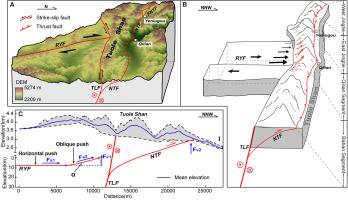Segmentation and deformation mechanisms of the North Tuole Shan fault in the Qilian Mountains: Insights from channel steepness index (ksn) and fault activity
IF 3.1
2区 地球科学
Q2 GEOGRAPHY, PHYSICAL
引用次数: 0
Abstract
The North Tuole Shan Fault (NTF) is a significant thrust fault system in the Qilian Mountains. Understanding its activity patterns and differential deformation characteristics is essential for deciphering regional tectonic uplift, crustal deformation mechanisms, and geomorphic evolution. However, the segmentation characteristics of this fault and their controlling factors remain poorly understood, hindering a comprehensive understanding of major fault evolution in the region. In this study, we extracted ksn values from 107 river channels along the northern slope of Tuole Shan in the central Qilian Mountains and compared them with previous findings on NTF activity. The results reveal a general consistency between fault activity variations and ksn distribution, indicating that ksn values serve as a reliable indicator for fault activity variations and their controlling factors. Further analysis suggests that ksn variations between the East and West Jingtie segments are predominantly governed by fault activity differences, with secondary influences from bedrock erosion resistance. Higher ksn values in the Qilian Segment are likely related to the transition of the Riyue Shan Fault (RYF) from dextral strike-slip motion to oblique thrusting at the fault tip. This transition intensifies tectonic loading, resulting in a simultaneous increase in ksn values and vertical slip rates. Existing studies on the strike-slip rate of the RYF, along with new analytical results, suggest that the angular variation involved in this kinematic transition is likely ≤30°. This suggests that, in addition to faulting and lithology, lateral extrusion associated with strike-slip faulting may also play a significant role in controlling adjacent fault activity and shaping the tectonic landscape. These findings offer novel insights into the mechanisms regulating fault activity variations.

祁连山北坨勒山断裂的分段与变形机制——来自河道陡度指数和断裂活动性的启示
北脱勒山断裂是祁连山地区一条重要的逆冲断裂系统。了解其活动模式和差异变形特征对解读区域构造隆升、地壳变形机制和地貌演化具有重要意义。然而,对该断裂的分段特征及其控制因素的认识尚不充分,阻碍了对该地区主要断裂演化的全面认识。本研究提取了祁连山中部沱乐山北坡107条河道的ksn值,并与前人的NTF活动性研究结果进行了比较。结果表明,断层活动性变化与ksn分布基本一致,说明ksn值可作为断层活动性变化及其控制因素的可靠指标。进一步分析表明,东、西泾铁段的ksn差异主要受断层活动性差异的支配,其次受基岩抗蚀性的影响。祁连段ksn值偏高可能与日月山断裂由右向走滑运动向断层尖端斜向逆冲运动转变有关。这种转变加剧了构造负荷,导致ksn值和垂直滑动速率同时增加。对RYF走滑率的现有研究以及新的分析结果表明,这种运动学转变所涉及的角度变化可能≤30°。这表明,除了断裂和岩性外,与走滑断裂相关的侧向挤压作用也可能在控制邻近断裂活动和塑造构造景观方面发挥重要作用。这些发现为断层活动变化的调节机制提供了新的见解。
本文章由计算机程序翻译,如有差异,请以英文原文为准。
求助全文
约1分钟内获得全文
求助全文
来源期刊

Geomorphology
地学-地球科学综合
CiteScore
8.00
自引率
10.30%
发文量
309
审稿时长
3.4 months
期刊介绍:
Our journal''s scope includes geomorphic themes of: tectonics and regional structure; glacial processes and landforms; fluvial sequences, Quaternary environmental change and dating; fluvial processes and landforms; mass movement, slopes and periglacial processes; hillslopes and soil erosion; weathering, karst and soils; aeolian processes and landforms, coastal dunes and arid environments; coastal and marine processes, estuaries and lakes; modelling, theoretical and quantitative geomorphology; DEM, GIS and remote sensing methods and applications; hazards, applied and planetary geomorphology; and volcanics.
 求助内容:
求助内容: 应助结果提醒方式:
应助结果提醒方式:


